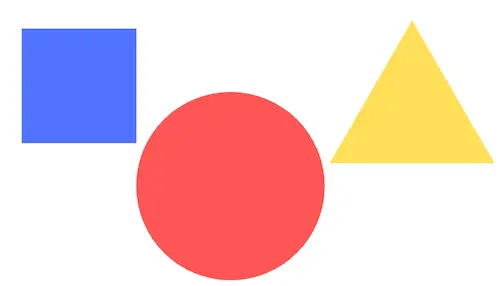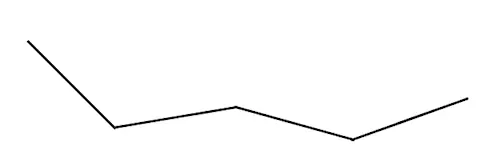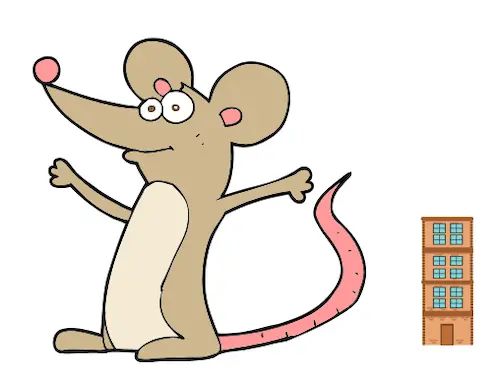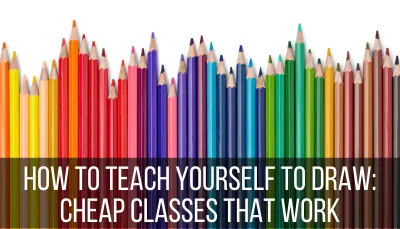All artists, regardless of experience, use 5 basic skills when creating their drawings. These skills make up the foundation of creating any piece of art, whether it’s a landscape, portrait, still life, or cartoon. Looking at intricate drawings, it can be easy to forget that every great work starts with these 5 basic skills.
The 5 basic skills of drawing are understanding edges, spaces, light and shadow, relationships, and, the whole, or gestalt. These 5 basic skills of drawing make up the components of a finished work of art when put together. These are the 5 basic drawing skills every artist needs to know.
You might be wondering how 5 skills can be the backbone of all types of drawing. Yeah, it surprised me at first too. But, you’ll notice that each of these skills covers a lot of territory. Think about how expansive an idea like “light and shadows” is.
Even though 5 skills doesn’t sound like a lot, each one of the skills takes a long time to master. Heck, I’ll be spending the rest of my life just trying to master these 5 basic skills. Let’s dive into the specifics of each one of them.
1) Edges: 5 Basic Skills of Drawing
Take a look at a drawing and you’ll see that every definable shape is just a collection of edges, or sides. A basic line drawing, a stippling piece, an intricate still life, a flowy landscape, they all need to understand how edges work in order to show you what’s actually happening and the shapes that are supposed to be depicted.
Understanding and making edges in your art are a part of the essential drawing skills you need to know.
Think back to Kindergarten when we first started drawing shapes.
We learned that a square has 4 sides, a triangle has 3 sides, and a circle has no sides. If we accidentally made a shape with 3 sides, it couldn’t be a square. A square had to have 4 sides. All of the squares we would encounter in the world for the rest of our lives would have 4 sides.
These edges became a way for us to understand the world.

As we grow as artists, we start interacting with a lot more edges. So many that we give up trying to count them. How many edges does a hand have?
A lot, probably. Counting would be a waste of time.
But, just like in the Kindergarten days, every time you form part of the outline of the hand, you’re making an edge. And, more importantly, you’re making a decision about that edge.
Where is it placed? At what angle? At what length?

Understanding how edges work and being able to draw them accurately is the difference between drawing a hand that looks like an egg and drawing a hand that looks like it could pop off the page as a real hand.
These edges are what help you determine the shapes you need for your drawing.
2) Space: 5 Basic Skills of Drawing
When we say the word “space” we’re referring to the space that your object takes up and the space that your object DOESN’T take up.
Think about a bagel. A bagel is defined by the warm, fluffy dough, but it’s also defined by the hole in the middle, or the empty space.
Without that empty space, you would have a hamburger bun or a ciabatta roll. Still delicious, but not a bagel.

Every shape takes up space. The space it doesn’t take up is called negative space.
Sometimes this negative space is just what’s outside of the object, like with a beach ball. Or, maybe it’s within the object like a bagel. In order to draw accurate shapes, you need to understand both of these concepts and how they work together.
To make things easier, think about negative space as nothing more than another collection of shapes. So, if the warm, fluffy dough of your bagel is a round shape, the empty center of it is also a round shape. Just like the bagel itself is a circle, the hole of the bagel is also a circle.
Looking at negative space is actually a great hack for artists who are stuck drawing an object. Many artists get caught up in focusing on just the shapes they are drawing.
Or, the bagel. But, by realizing that the hole of the bagel is just as much of a shape as the bagel itself, you’ll have an easier time drawing both the bagel and it’s hole.

Instead, focus on the negative space. The reason this trick works is because our brains are used to looking at a bagel as a bagel. It’s a familiar object, which makes it hard for us to disassociate it from the images we have of it in our memory.
But, when we look instead at the bagel’s negative space, it becomes more abstract.
Suddenly, we aren’t looking at a common object, we’re looking at a collection of shapes. Our brains don’t understand what we’re looking at and, as a result, breaks it down into basic parts. Looking at negative space helps you see what is actually happening from a basic shape perspective.
3) Light and Shadow: 5 Basic Skills of Drawing
When thinking about the things we need to know about drawing, light and shadow is fundamental.
Think about looking at your room in the middle of the night when the lights are out. Now, think about suddenly flipping the switches and getting flooded with light.
In one instance, the room was too dark for you to be able to make out any shapes. In the next, the room was so light that you could barely look around you without squinting. This is not an example of how lights and shadows work exactly, but it’s an example of how we perceive them. Or, don’t perceive them.
When there are too many shadows, like when we’re in a pitch black room, we can’t distinguish one object from another. The chair in the corner might as well be a nightstand or a standing lamp.
When we flip on the lights and we’re blinded to the point of squinting, the situation is the same. Having too much shadow or too much light doesn’t work. You need a balance of both in order to understand what a shape is and how it functions in the world.
Light and shadow is created by light hitting an object, which gives it the definition and depth that makes it look realistic.
Many artists use shading to represent the light and shadow in an object. The deeper the shading, the deeper the shadow. The lighter the shading, the lighter the highlight.
In order to understand light and shadow, you also need to understand color. Even if you’re drawing a black and white image with a graphite pencil, your reference image will likely be in color. Heck, if your reference photo is in black and white, it’s still important to understand how the colors play a role in that scene.

We live in a multi-color world. When light hits objects, that light impacts the colors we see, which then impacts the way we draw the light and shadows.
Notice how bright lights fade colors until they are almost fully faded. Notice how shadows dampen colors until they are almost fully saturated. If you’re drawing in black and white, this understanding of color will impact the tones of your shadows and highlights.
If you’re drawing in color, naturally, it becomes really important to understand color. Take a look at the colors of an object as the light hits it. It’s not that you’re suddenly pushing harder or lighter on the same color of colored pencil.
No, those lights and those darks are completely different shades of color altogether. Notice how lights and shadows completely change and expand your color palette.
There’s no doubt that shadows are a part of the basic drawing skills we need to know
4) Relationships: 5 Basic Skills of Drawing
When you’re working on a drawing, every single line has a relationship with every other line on the page. Remember how a square has four sides?
Well, if we don’t put those sides together in the right way, we could end up with a weird looking abstract inchworm. All of the sides need to work together to form a square.
They can’t be looked at as isolated lines. How do lines come together to make the shapes we’re working on? A hand is only a hand if it has a certain number of rounded, bent, and straight lines that come together to form the shape of a hand.

In the same way that the lines of an object need to work together to make an accurate representation of that object, so too do objects need to work together with other objects. If I put a mouse next to a building, that building better be bigger than the mouse if they’re on the same plane.
Every single thing that you draw on your piece of paper has a relationship with every other thing on your paper. You need to make sure that these relationships make sense so that your overall piece of art makes sense.
Sometimes, you need to understand complicated techniques like perspective in order to make the relationships between your objects work. For example, it would make sense for the mouse to be bigger than the building if the building is a mile behind the mouse and our vantage point is right in front of the mouse. You need to nail that perspective in order for it to work though.

When you’re looking at your drawing, think about how all of your elements work together to make your final piece of art. If something looks off, consider if something is wrong with the relationships, whether within the object itself or between the objects on the page.
It’s really important to understand the relationships within your drawing before you start.
If you’re like me, you’ve drawn the head of a person only to realize that you didn’t leave enough room for the body. You get creative and find a way to show your character kicking a soccer ball even if you had to cut them off at the torso, but ideally, you would have planned better.
It can be really helpful to do a basic sketch of where all of your objects will go before you get started. This will give you an idea of any potential hiccups before you get too far along. No more body-less heads around here!
5) The Whole, or Gestalt
This last one is a bit of a trick. It isn’t a new, isolated skill. Instead, it’s the ability to put skills 1-4 together. You may have noticed that skills 1-4 have a lot of similarities. For example, our edges from #1 are often created through the lights and shadows we talked about in #3.
Even though they are stand alone skills, they share similarities and can be used together. In fact, they SHOULD be used together. This is what skill #5 is all about.
When we draw, we naturally integrate all of the skills we’ve talked about. We create negative space as we build the edges of our objects.
We create light and shadow as we understand how one object is positioned in relation to another. These are skills we naturally work on integrating as artists every day. These are skills we aim to master.
So, as an artist, do you have mastery of all 4 of the skills we’ve talked about?
No, I don’t either. These are skills that all of us, no matter our skill levels, will all be working on for the entirety of our artistic lives. Even when we think that we’ve mastered one of them, there’s a way to step it up to the next level or use it in conjunction with another skill that we haven’t explored before.
That’s why art is amazing! We’ll never run out of ways to grow and improve.
Learn the Rules of Art so You Can Break Them
These 5 skills that we’ve talked about make up the foundations of drawing. As we build our skills and learn different techniques, we learn why these skills are important and how to implement them.
We follow certain formulas when drawing in perspective, get specific about how shadows are being cast on a still life, and want to make sure that our angles are exactly perfect. At some point though, we want to get creative. I mean, it’s art, isn’t it?
Once you have a strong foundation in these 5 basic skills, go ahead and break them. Heck, throw them out the window.
Anyone who has seen even a small sampling of art knows that rules are meant to be broken. Where would artists like Picasso fit in if we had zero tolerance for breaking rules? Many would say that the whole point of art is to break rules.
It’s important to have a solid understanding of the rules first though. Once you know them inside and out, you’ll get a sense of what you can manipulate and what you can’t. You’ll have a greater sense of control as you rely on traditional techniques as a foundation for a new way of drawing and creating.
For many artists, going back to basics sounds boring. There is so much creativity to explore, which makes it hard to go back to shading and shape exercises. Even someone as neurotic and detail oriented as I am struggles with it. That said, going back to basics can make a world of difference in your art.
It’s like baking a cake from memory and then finally realizing that you’ve been forgetting the baking powder all along after taking a second to read the recipe again. What’s the baking powder that you’ve accidentally been leaving out of your art recipe?

Diana has been an artist for over 27 years and has training in drawing, painting, digital drawing and graphic design. Diana’s latest obsession is digitally drawing with Procreate and Procreate Dreams. Diana has experience selling her art across a number of platforms and loves helping other artists learn how to make money from their art as well.


